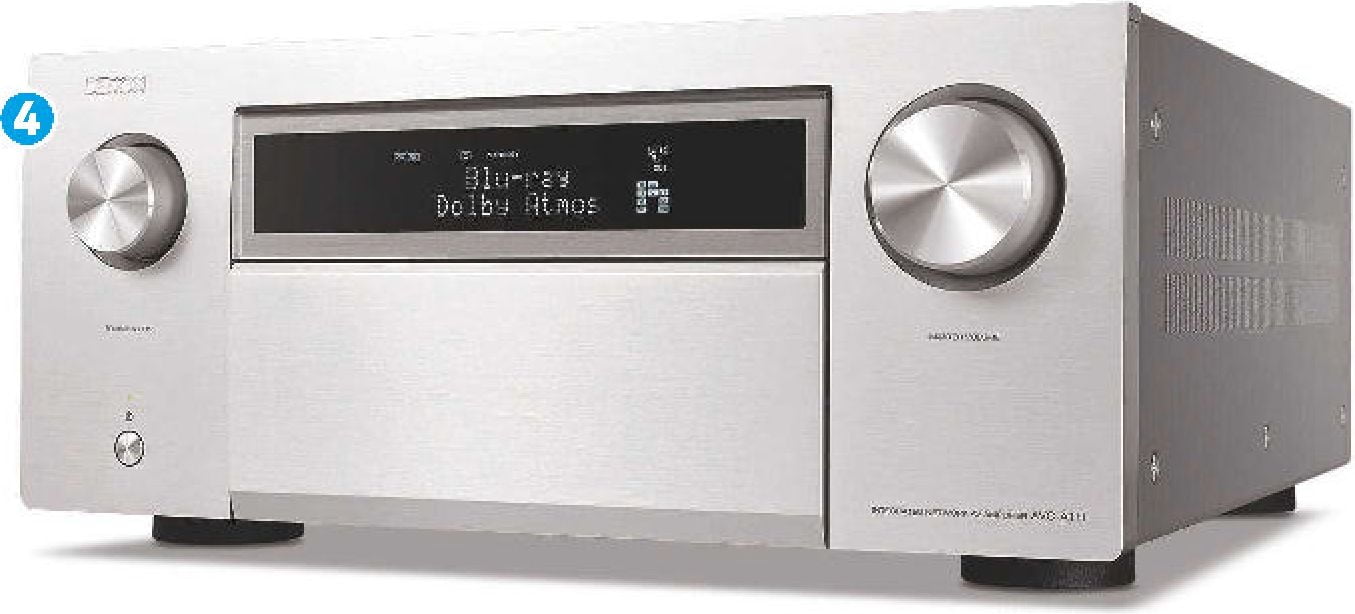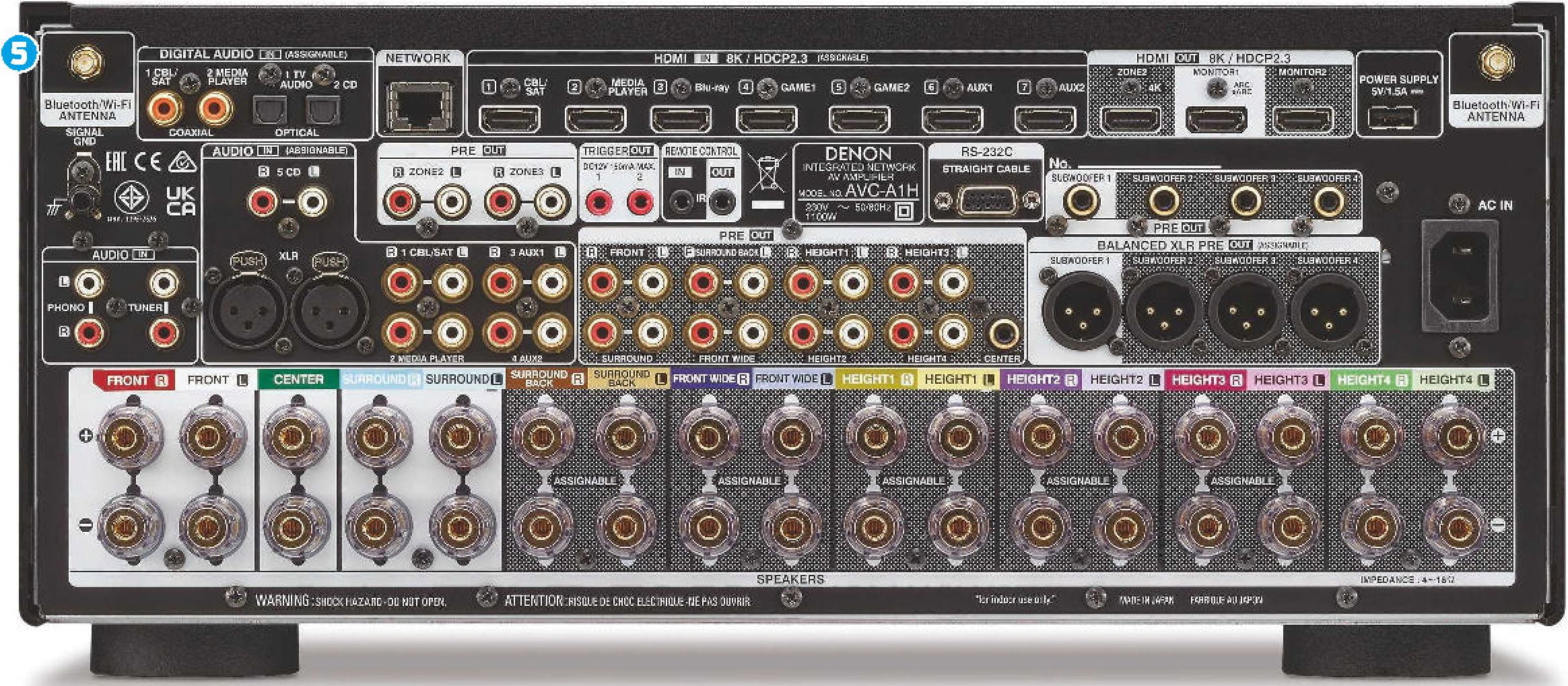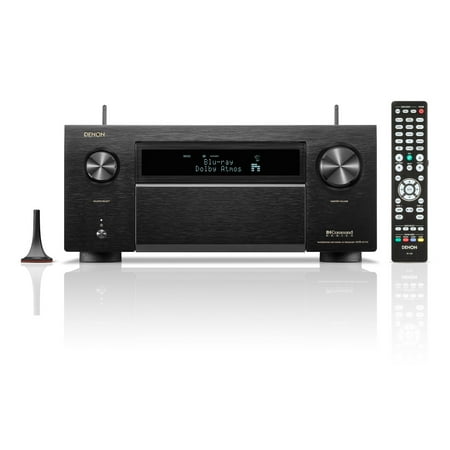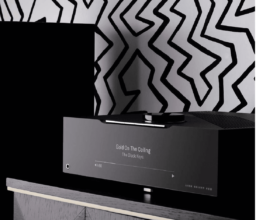Denon AVC-A1H AV Receiver Review
Just when you think Denon can’t outdo itself, the 15-channel Denon AVC-A1H arrives and proves you wrong…
Three years ago, to celebrate their 110th anniversary, Denon launched their best home theater amplifier: the AVC-A110. This true flagship surpassed its predecessor, the AVC-X8500H, by featuring an impressive 13 amplifier channels.
I couldn’t help but describe the Denon AVC-A110 as “a spectacular standout among surround amplifiers.” It boasted an even more refined and precise sound than its predecessor. There was an abundance of power, and with 13 channels, it could fill a high-end home theater with many speakers.
However, for an amplifier of this caliber, I missed having XLR connections, especially for the subwoofers. The speaker terminals also felt somewhat plasticky.
15 CHANNELS AND XLR WHERE IT COUNTS
It’s great to see that the new AVC-A1H addresses previous concerns. It now includes balanced XLR outputs for all four subwoofer outputs and features a stereo XLR input for an optional audio source. With an extra pair of channels, it can now calibrate and process a full 15 channels simultaneously, plus adjust for up to four separate subwoofers!

If you don’t need a balanced operation for the subwoofers, the XLR outputs can be redirected to a headphone amplifier or balanced power amplifiers for the front channels.
IMMERSIVE SOUND DEMANDS MORE CHANNELS
Immersive audio formats are becoming increasingly popular. Two years ago, having 13 channels seemed excessive, but the demands of some home theater enthusiasts have grown even further. For example, if you have a home theater where the front speakers are hidden behind a projection screen, this limits the distance between them. Therefore, having a pair of front-wide speakers helps to bridge the sound image between the front and rear. We’d also like four rear channels, bringing us to a total of nine speakers at ear level.

Then there are the ceiling speakers. Two are a minimum, four are desirable, but some would love to have six to truly maximize the immersive experience.

Not least because there are still quite a few Dolby Atmos movies and music tracks where front wide speakers are part of the soundscape. In many cases, you won’t hear anything from these speakers, so it’s nice to have extra point sources in the ceiling to help tie the sound together.
Now, I won’t claim that you actually need 15 channels in your home theater. I haven’t even managed to set up such a large speaker system for this test, and have had to settle for 13. But some will certainly find use for so many channels, and the expectations in the high-end class are that the amplifier should be able to deliver. Those who can make do with 13 channels can look more closely at the AVC-A110, which is still available and offers much of the same sound quality.
9.1.6
Having 15 channels means that the AVC-A1H can power a 9.4 surround system (yes, four separate subwoofers) plus six additional ceiling speakers (9.1.6). If you plan to use fewer speakers, you can use the redundant amplifier channels to bi-amplify the front speakers or allocate them to other zones in your home, such as a stereo setup in the bedroom.
MORE POWERFUL CAPACITORS
The power per channel is rated at 150 watts into 8 ohms with two channels driven simultaneously, the same as the A110 and X8500H. However, there are some key differences. The A1H boasts a much larger capacitor bank. Each capacitor in the power stage is 22,000 µF in the predecessors, but in the A1H, they are a substantial 33,000 µF. These are 4-pole capacitors, which reduce resistance due to magnetic influence (inductance).
The transformer, mounted on a 2 mm thick copper plate, weighs a hefty 11.5 kg! This is 41 percent heavier than the one in the X8500H and A110, contributing to the AVC-A1H’s significant mass, tipping the scales at 32 kg, which is 9 kg more than its predecessors.
HDMI WITH 8K
The AVC-A110 had 4K/120 Hz and 8K/60 Hz in a single HDMI input, while the AVC-A1H offers this capability in all seven HDMI inputs. Though not widespread yet, this means you can connect a gaming PC or console and ensure the frame rate or resolution is not bottlenecked by the processor.
To support the latest HDMI formats along with numerous high-resolution audio channels, Denon upgraded the processor to a dual-core 1 GHz processor, doubling the clock frequency of its predecessors.
AURO-3D
An alternative speaker format to the well-established Dolby Atmos and DTS, also supported by the amplifier, is Auro-3D. It employs a different speaker placement where each ear-level speaker has a corresponding speaker in the ceiling. Therefore, 5.1 becomes 10.1, and 7.1 becomes 14.1. The reason I write .1 instead of .4 is that the bass effects from the source have only one channel, no matter how many subwoofer channels the Denon amplifier can process.
The format sounds fantastic with recordings made in Auro-3D, but the selection is so limited that this is primarily for enthusiasts. Therefore, I recommend using a Dolby Atmos speaker system instead and living with the slight compromise when listening to Auro-3D. It will still sound excellent…

SIMULATED SOUND FROM ABOVE
If you cannot or do not want to install speakers in the ceiling or place them on top of the main speakers, the Denon AVC-A1H offers Dolby Atmos Height Virtualization and DTS Virtual. These technologies use advanced digital signal processing to simulate height channels from a traditional speaker system. While it has its sonic limitations, if you absolutely cannot deal with ceiling speakers, it provides a significantly enhanced illusion of 3D sound compared to having it turned off.
IMAX ENHANCED
The AVC-A1H is IMAX Enhanced certified, a feature you can enjoy with a variety of film titles available on Disney Plus.
IMAX Enhanced is not a specific video or audio format but a certification ensuring optimal playback of both audio and video. It ensures that HDR reproduction is top-notch and that the sound quality meets high standards. On the audio side, DTS is almost always used.
Personally, I don’t consider it crucial for a home theater amplifier to support every conceivable format, at least not on the video side. If future video formats emerge that are not supported, you can simply connect the video source to the TV and then retrieve the audio to the amplifier via the audio return channel (eARC).
User-Friendliness
Despite being an incredibly advanced machine, the AVC-A1H is relatively easy to use. The first time you turn it on, it guides you step-by-step on which cable to connect to which input. It then plays some music in one channel at a time so you can hear if you’ve connected everything correctly as the music moves from speaker to speaker.
For example, I noticed that I had swapped a Surround channel and a Surround Back channel. It was easy to spot and just as easy to fix.

Room Correction
The amplifier features built-in room correction of the type Audyssey MultEQ XT32. This is an old but well-proven system that calibrates the speakers in the room as automatically as possible. You must calibrate for at least three positions in the room, but ideally eight, so that the system can gather as much information about the acoustics as possible. With up to fifteen speakers plus subwoofers, it takes a while, but it is well worth it.
The Audyssey correction works very well and makes all the speakers sound as similar as possible, also adjusting the timing and sound levels between them. So, when everything is finished, you get a large bubble of sound around you.
Audyssey’s Weakness
I miss that the Audyssey system does not have multiple options for tonal ideals after calibration. With the speakers behind our perforated DreamScreen V6 projection screen, the treble is slightly dampened. Enough that I do not want to use the Bypass L/R sound mode. Otherwise, it is worth its weight in gold if you, for example, have a pair of high-end speakers as fronts and want the rest of the system to emulate them.
But I would have liked to calibrate the speakers behind the projection screen, and then you have Flat, which evens out the entire frequency response to be as linear as possible. It sounds too thin and sharp for me. Then there is only Audyssey Reference, which is a tonal ideal that Audyssey has determined. It is the best compromise in our test room. However, I still think the treble is a bit too lively.
Dirac Live
But Denon has yet another ace up its sleeve: Dirac! This requires purchasing a license but can be worth it if you miss the ability to design your own frequency curve for the system to follow. The correction system itself is also much more advanced. It is far from as user-friendly, but the result is better when you take the time.
Storage Memories
Just like the A110, the A1H can store speaker calibrations in two different memories. For example, if you want to find out if 7.1.6 or 9.1.4 works best, you can run two separate calibrations and listen back and forth before deciding. You just need enough speakers to test with first.
Or you can do two different calibrations for different seating positions – or how about one calibration for home theater and a completely different one for stereo listening with another speaker pair? You can also use the memories to switch between configurations with and without a subwoofer. For instance, if you want a variant without a subwoofer for late nights when you don’t want to disturb others trying to sleep. There are many possibilities.
Installation
Denon has a very simple step-by-step installation guide that walks you through speaker setup and source connection. The speaker calibration takes a while, as you should calibrate with at least six microphone positions in the room, preferably eight. Before everything is finished, it takes about half an hour. Afterward, it’s advantageous to go through manually to ensure that crossover frequency, distance, and sound level look correct. Our Procella speakers are almost always set to cross over at 40 or 60 Hz, but in reality, they should be crossed over at 80 Hz. The subwoofer also needs to be checked to ensure it is set to 80 Hz and not lower, so it isn’t heard too poorly – or higher, so it overlaps too much.


A CALL TO ARMS
Having just tested six high-end soundbar speakers, it’s almost shocking how much better, bigger, and richer the sound is with this system.
First up is our regular 7.1.2 setup with Procella speakers plus a pair of Martin Logans in the ceiling. The control over every shot in “All Quiet on the Western Front” is so superior that there’s simply no comparison, and the dialogues are clear and crisp. The soundstage breathes, and when the wind rushes through the forest at the beginning of the film, it’s portrayed incredibly convincingly.
The two height channels lift the sound, but the objects aren’t placed as precisely as I had hoped. It’s almost as if the walls are gone and we’re drawn into the action of the film. But not quite.
THIRTEEN SPEAKERS ARE AMAZING
With all thirteen speakers, it’s a whole different ball game. You get closer to the rustling of the trees in the forest, the wind swirls around us, and something else really cool happens. When I get up from the couch and move around the room, the soundstage is much more cohesive.
Approaching the fronts, the sound naturally becomes louder from there. But the timing from the channels at the back and above remains unaffected. The soundstage is much more synchronized, even as you move around the room. It makes the experience optimal for many more seating positions than with fewer channels. Even though there are many speakers of different kinds in the system, the amplifier has smoothed out the differences so that the speakers actually sound like a cohesive unit.
Note: “All Quiet on the Western Front” in Dolby Atmos doesn’t have any sound in the Front Wide, so in reality, eleven speakers are used. Among films that actually use Front Wide, you’ll find “Wonder Woman” and “Aquaman”; you’ll find many more if you look around a bit. With Front Wide, the soundstage becomes even more cohesive and expansive. The difference is most noticeable in a larger room; our room doesn’t really need these channels. Sure, it gets better, but maybe it’s not worth the extra effort or cost for an extra pair of speakers.
MUSIC IN ALL CHANNELS
Many movies feature incredibly atmospheric surround music. But for a truly immersive music experience, I encourage you to listen to one of 2L’s many fantastic releases. For instance, “Tuvayhun” with Kim André Arnesen, accompanied by the Nidaros Cathedral Girls’ Choir and the Trondheim Soloists. It’s an absolutely stunning recording that’s much more musically accessible than many of 2L’s more esoteric recordings.
The album is a poignant nod to the world’s problems with environmental crises, mass migration, political polarization, and, notably, how children suffer. The songs have a religious starting point, but even atheists might find themselves choked up.
Here, you’ll find deep organ tones and feather-light solo voices. The church’s space expands around us, and the musicians are precisely placed in different positions in the room. The stage is vast, with the sound also echoing above us.
I’ve listened to this recording extensively in stereo, but it’s with immersive surround sound that it truly shines in all its magnificent glory. With the Denon amplifier, layers upon layers of airiness emerge, and the dynamics are even better than with the already fantastic AVC-A110.
MUSIC IN STEREO
For stereo music, the amplifier integrates the HEOS user interface with streaming. Many services are supported, but you won’t get MQA audio or Dolby Atmos from Tidal.

Still, the sound quality is very good. The A1H is even a notch better than the A110 regarding control and composure. It might not have quite the same power and control as the retro NAD C 3050 LE amplifier, nor the large, expansive, and warm soundstage of the Denon PMA-1700NE. But it delivers a comprehensive musical experience with great conviction.
For fun, I tried connecting the A1H to the enormous and expensive DALI Kore speakers currently occupying our testing room. The amplifier doesn’t do justice to a pair of speakers worth 800,000 kronor, but it doesn’t feel like it needs to hide in shame, either. There’s speed and punch here, and it sounds good.
SPECIFICATIONS
| Product | Flagship AV amplifier |
| Position | At the top of Denon’s AV range by some distance |
| Peers | Anthem MRX 1140, Arcam AVR31, Rotel RAP-1580 MkII |
| Website | www.denon.co.uk |
| Dolby Atmos | Yes |
| DTS | Yes (Pro) |
| IMAX Enhanced | Yes |
| Multichannel Input | No |
| Multichannel Pre-Out | Yes. 17.4 |
| Multichannel Output (claimed) | 15 x 150W (into 8 ohms, 20Hz-20kHz, two channels driven) |
| Multiroom | Yes. Three zones, plus HEOS |
| AV Inputs | 4 x digital audio (2 x optical and 2 x coaxial); 8 x analogue stereo |
| HDMI | 7 x inputs; 3 x outputs |
| Dimensions (WxHxD) | 434 x 195 x 498 mm |
| Weight | 32 kg |
| Features | Audyssey MultEQ XT32 room EQ with MultEQ-X and Dirac Live upgrade options, 8K video passthrough/upscaling, HEOS and AirPlay streaming, 360 Reality Audio and MPEG-H immersive audio, 32-bit DACs, 32-bit DSP, up to four independent subwoofers, XLR subwoofer connections, balanced XLR stereo input, phono (MM) input, control system integration, backlit metal remote control |
Speaker System:
The fixed speaker system in our test room is a Procella THX in a 7.1 configuration, with a pair of ceiling-mounted Martin Logan SLM for Atmos content. This is what I primarily listen to. Of course, the Denon amplifier deserves to be tested with more channels than that. It’s a challenge as I don’t have access to enough speakers of the same type, but this is where the Audyssey setup comes in and evens out the differences. In the alternative setup, I have the following speakers:
- Front: 2 x Procella P6
- Center: Procella P6
- Front Wide: 2 x B&W 702 S3
- Surround: 2 x JBL L52 Classic
- Surround back: 2 x B&W 705 S3
- Top front: 2 x Martin Logan SLM
- Top back: 2 x Procella P6
- Subwoofer: Procella P15
CONCLUSION
The AVC-A1H stands as Denon’s best multi-channel amplifier to date. By a significant margin. Not only does it boast a staggering number of speaker channels, but it also sounds even better than its predecessors.
In surround sound, it offers both Audyssey and Dirac room correction, with the latter requiring a licensed fee.
The audio quality is delightful, and the more speakers it drives, the more cohesive and lively the soundstage becomes. The dynamics are excellent, vocals and dialogue sound fantastic, and channel separation is superb.
Even in stereo music playback, it shines brilliantly, maintaining both control and resolution.
This is a true end-game amplifier for enthusiasts willing to go above and beyond to fulfill their home theater dreams.
When you purchase through links on our site, I may earn an affiliate commission. Here’s how it works.
Denon AVC-A1H 2023, 15.4 channel AV amplifiers made in Japan Transformer of 11.5kg | AVR-A1H
hxosplus #deepunboxing.







